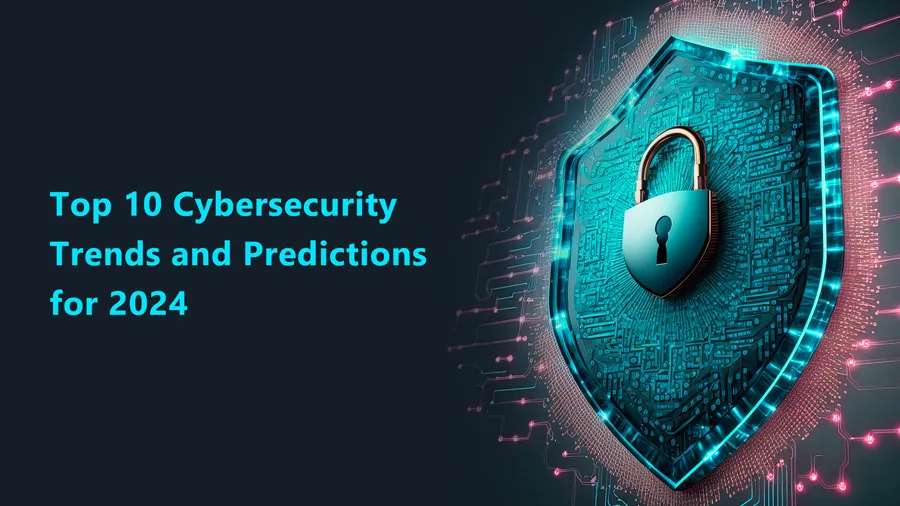As we stride into the future, the digital landscape continues to evolve, presenting new challenges and opportunities in the realm of cybersecurity. With cyber threats growing in complexity and sophistication, it’s crucial for organizations to stay abreast of the latest trends to safeguard their assets effectively. In this article, we’ll delve into the top security trends anticipated to shape the cybersecurity landscape in 2024, empowering organizations to fortify their defenses and stay ahead of emerging threats.

- Quantum-Safe Encryption:
With the advent of quantum computing on the horizon, traditional encryption methods face unprecedented vulnerabilities. In response, organizations will increasingly adopt quantum-safe encryption algorithms to shield their sensitive data from the looming threat of quantum attacks. Implementing robust encryption protocols will be paramount to ensure data confidentiality and integrity in the quantum era. - AI-Powered Threat Intelligence:
Artificial Intelligence (AI) and Machine Learning (ML) will continue to revolutionize cybersecurity, empowering organizations to bolster their threat detection and response capabilities. AI-driven threat intelligence platforms will leverage advanced algorithms to analyze vast datasets and identify anomalies indicative of cyber threats. By harnessing the power of AI, organizations can proactively mitigate risks and thwart emerging threats with greater precision and efficiency. - Zero Trust Architecture (ZTA):
In an era characterized by pervasive connectivity and remote work, the traditional perimeter-based security model is no longer sufficient to defend against sophisticated cyber attacks. Zero Trust Architecture (ZTA) will emerge as the cornerstone of modern cybersecurity, emphasizing the principle of “never trust, always verify.” By implementing stringent access controls and continuous authentication mechanisms, organizations can adopt a proactive stance against insider threats and unauthorized access attempts. - Cloud Security Posture Management (CSPM):
As cloud adoption continues to soar, ensuring the security and compliance of cloud environments will be paramount for organizations across industries. Cloud Security Posture Management (CSPM) solutions will enable organizations to assess, monitor, and remediate security risks and compliance gaps in their cloud infrastructure. By implementing CSPM tools, organizations can bolster their cloud security posture and safeguard their data against unauthorized access and data breaches. - Identity-Centric Security:
In an increasingly interconnected and hybrid IT environment, securing identities and access privileges will be imperative to prevent unauthorized access and data breaches. Identity-Centric Security solutions will empower organizations to adopt a risk-based approach to identity management, leveraging advanced authentication mechanisms and behavioral analytics to detect and mitigate identity-related threats. By prioritizing identity security, organizations can fortify their defenses and thwart cyber adversaries’ attempts to exploit identity-based vulnerabilities. - Supply Chain Cybersecurity:
As supply chains become increasingly interconnected and digitized, they emerge as prime targets for cyber attacks. Supply Chain Cybersecurity will take center stage as organizations seek to mitigate the risks posed by third-party vendors and suppliers. By implementing robust vendor risk management practices, conducting regular security assessments, and enhancing supply chain visibility, organizations can safeguard their supply chains against cyber threats and ensure business continuity. - Privacy-Enhancing Technologies (PETs):
With data privacy regulations becoming more stringent and pervasive, organizations will embrace Privacy-Enhancing Technologies (PETs) to protect sensitive data and uphold privacy rights. PETs, such as differential privacy, homomorphic encryption, and secure multiparty computation, will enable organizations to anonymize and encrypt data while preserving its utility and integrity. By integrating PETs into their data protection strategies, organizations can demonstrate compliance with regulatory requirements and enhance consumer trust. - IoT Security:
The proliferation of Internet of Things (IoT) devices will continue to introduce new security challenges. IoT Security solutions will focus on securing connected devices, networks, and data streams from cyber threats. By implementing IoT security best practices such as device authentication, encryption, and firmware updates, organizations can mitigate the risk of IoT-related attacks and protect their critical infrastructure. - Cyber Resilience:
Building cyber resilience will be essential for organizations to withstand and recover from cyber attacks and disruptions. Cyber Resilience strategies will focus on proactive threat hunting, incident response planning, and business continuity management. By developing robust incident response plans and conducting regular cyber resilience exercises, organizations can minimize the impact of cyber incidents and maintain business operations. - Skills Development and Training:
Addressing the cybersecurity skills gap will remain a significant challenge for organizations. Investing in cybersecurity training and skills development programs will be essential for building a resilient cybersecurity workforce. By providing employees with the necessary training and resources, organizations can empower them to identify and mitigate security threats effectively.
Conclusion:
As we navigate the complex and dynamic cyber landscape of 2024, organizations must remain vigilant and proactive in addressing emerging threats and vulnerabilities. By embracing these top security trends and leveraging innovative technologies and strategies, organizations can bolster their resilience against cyber threats and safeguard their digital assets in an increasingly interconnected and digitized world. Together, let’s embrace the future of cybersecurity and forge a path towards a more secure and resilient digital future.
